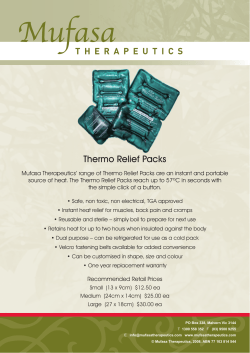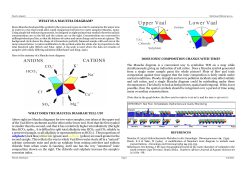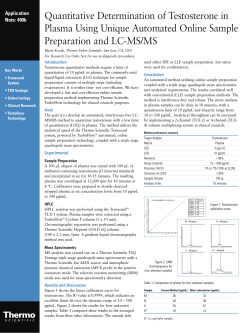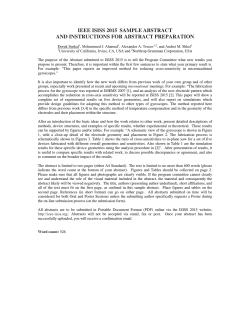
Measuring pH in Low Ionic Strength Solutions
Water Analysis Instruments, Thermo Fisher Scientific Appl i cati o n No te 006 Measuring pH in Low Ionic Strength Solutions Key Words pH, low ionic strength, pure water, electrodes, solutions, ROSS, ROSS Ultra, water conductivity, pHISA adjuster, pure water pH test kit. Goal The following application note describes the challenges and recommendations when measuring pH in low ionic strength solutions. Introduction pH measurements are typically made in solutions which contain relatively large amounts of acid or base, or which contain substantial amounts of dissolved salts. Under these conditions, conventional pH electrodes make measurements with speed and precision. There is a strong interest in making pH measurements in “pure water” (for example, waters in which the total amount of acid or base is very small, and in which there is a low level of dissolved salts). The terms “pure water” and “low ionic strength” can be used interchangeably. Samples which may fall into this category include: • Distilled waters • Deionized waters • Some process waters • Well waters • Some surface waters • Treated effluent water • Boiler feed water Measuring pH in these pure water samples can be difficult. Although electrodes respond quickly in buffers, their response in pure water can be unsatisfactory – slow, noisy, drifting, non-reproducible, and inaccurate. The Problem These commonly observed problems can be attributed to the low conductivity of the sample, differences between low ionic strength solutions and normal ionic strength buffers, changes in the liquid junction potential, and absorption of carbon dioxide. Because pure water samples are poor conductors, the solution will often behave like “antenna,” and the electrode response can be noisy. Standardization of an electrode in a high ionic strength buffer will increase the time required for stabilization when going to a low ionic strength solution. In addition, the possibility of sample contamination will be increased. To ensure the most precise measurements, buffers and samples should close in ionic strength. When any two solutions come in contact, diffusion occurs until equilibrium is reached. Since ions have different mobilities and diffuse at different rates, a charge imbalance occurs causing a junction potential. A junction potential occurs when the reference electrode fill solution meets the sample. Since pure waters contain little dissolved material, their buffering capacity is small. Absorption of carbon dioxide from the atmosphere will cause a slow change in the pH, which is observed as a drift in pH reading and a different pH from the original sample. Samples which are not previously saturated with carbon dioxide must be handled with care. Conventional Approaches The most widely accepted approaches to solving these problems involve the use of low resistance glass pH electrodes or the use of a reference electrode with a fast, continuous leak rate. When placed in a pure water sample, these electrodes show improved time response and stability, due to dissolution of the low resistance glass into the low ionic strength solution and the nonquantitative addition of a salt solution from the reference into the sample respectively. Both techniques raise the conductivity, but, at the same time, may change the sample pH at the electrode surface. Response is improved, but an error is added to the measurement, which depends upon the amount of dissolved material. Increased sample conductivity is desirable; however, non-reproducible alteration of the pH reading is not. Recommended Electrodes and Solution When measuring pH in low ionic strength solutions, the following equipment is recommended to overcome the challenges presented by the conventional approaches: • Thermo Scientific™ Orion™ ROSS™ electrode or Thermo Scientific™ Orion™ ROSS Ultra™ electrode • Thermo Scientific™ Orion™ Pure Water™ pH Test Kit The kit includes the Thermo Scientific™ Orion™ pHISA™, a pure water pH additive and a special set of buffers containing the same background of pHISA adjustor. Adding pHISA adjustor to samples increases the ionic strength, thus reducing noise and improving response time. The shift in pH caused by the addition of pHISA adjustor is minimal, between 0.005 and 0.01 pH units. Since the same amount of pHISA adjustor is added to the buffers and samples, the net effect on the pH is negligible. Conclusion Calibration is performed using special dilute buffers with pHISA adjustor already added. Measuring with samples and buffers of the same ionic strength increases accuracy, precision, and response time. Contamination due to carryover from higher ionic strength buffers is also minimized. Errors in pH measurement due to liquid junction potential variations are minimized by using buffers and samples at similar ionic strength. Addition of pHISA adjustor to both the buffers and samples achieves this condition. Junction potentials will vary depending on the style of junction and choice of electrode fill solution. A good quality pH electrode will provide better response when compared against the universal standard, the hydrogen electrode. To optimize the measurement, we recommend using the same Orion ROSS electrode. To purchase an Orion ROSS electrode or the Orion Pure Water pH Test Kit, please contact your local equipment distributor and reference the part numbers listed below: Product Description Part Number Thermo Scientific Orion ROSS Ultra pH Electrode Thermo Elecrode Accessories Scientific™ Orion™ Ultra™ Glass Triode™ ROSS Combination Electrode 8102BNUWP pH/ATC 8302BNUMD Thermo Scientific Orion ROSS Ultra Low Maintenance pH/ATC Triode Combination Electrode 8107BNUMD/8107UWMMD Thermo Scientific Orion ROSS Ultra Refillable pH/ATC Triode Combination Electrode 8157BNUMD/8157UWMMD Thermo Scientific Orion Pure Water pH Test Kit 700001 thermoscientific.com/water © 2014 Thermo Fisher Scientific Inc. All rights reserved. All trademarks are the property of Thermo Fisher Scientific and its subsidiaries. Water Analysis Instruments North America Toll Free: 1-800-225-1480 Tel: 1-978-232-6000 info.water@thermo.com AN-PHLOWION-E 0914 RevA Netherlands Tel: (31) 020-4936270 info.water.uk@thermo.com India Tel: (91) 22-4157-8800 wai.asia@thermofisher.com Japan Tel: (81) 045-453-9175 wai.asia@thermofisher.com China Tel: (86) 21-68654588 wai.asia@thermofisher.com Singapore Tel: (65) 6778-6876 wai.asia@thermofisher.com Australia Tel: (613) 9757-4300 in Australia (1300) 735-295 InfoWaterAU@thermofisher.com Appl i cati o n No te 006 This will be large if there is a large difference in composition between the fill solution and the sample. It is important that the junction potential be constant during measurement. If the two solutions are quite different, normal fluctuations in the boundary layer will produce noise. Constant, reproducible junction potentials are achieved by measuring in samples and standards with ionic strengths similar to the fill solution.
© Copyright 2025










